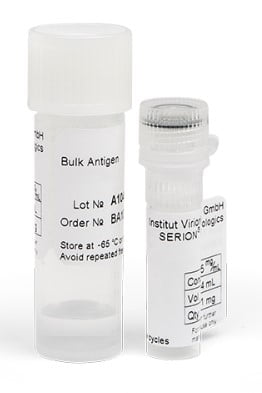| Weight | 1 lbs |
|---|---|
| Dimensions | 9 × 5 × 2 in |
| host | rabbit |
| isotype | IgG |
| clonality | polyclonal |
| concentration | 1 mg/mL |
| applications | ICC/IF, WB |
| reactivity | GRIM-19 |
| available sizes | 100 µg |
rabbit anti-GRIM-19 polyclonal antibody 6030
$9,999.00
Antibody summary
- Rabbit polyclonal to GRIM-19
- Suitable for: ELISA
- Isotype: Whole IgG
- 100 µg
rabbit anti-GRIM-19 polyclonal antibody 6030
| antibody |
|---|
| Tested applications ELISA |
| Recommended dilutions Immunoblotting: use at 1:500-1:1,000 dilution. A band of approx. 16kDa is detected. Positive control: HeLa cell lysate. These are recommended concentrations. End user should determine optimal concentrations for their applications. |
| Immunogen Recombinant human GRIM-19 protein. |
| Size and concentration 100µg and lot specific |
| Form liquid |
| Storage Instructions Store at 2 - 8°C until expiration on packaging. |
| Storage buffer PBS, pH 7.4. |
| Purity peptide affinity purification |
| Clonality polyclonal |
| Isotype IgG |
| Compatible secondaries goat anti-rabbit IgG, H&L chain specific, peroxidase conjugated, conjugated polyclonal antibody 9512 goat anti-rabbit IgG, H&L chain specific, biotin conjugated polyclonal antibody 2079 goat anti-rabbit IgG, H&L chain specific, FITC conjugated polyclonal antibody 7863 goat anti-rabbit IgG, H&L chain specific, Cross Absorbed polyclonal antibody 2371 goat anti-rabbit IgG, H&L chain specific, biotin conjugated polyclonal antibody, crossabsorbed 1715 goat anti-rabbit IgG, H&L chain specific, FITC conjugated polyclonal antibody, crossabsorbed 1720 |
| Isotype control Rabbit polyclonal - Isotype Control |
| target relevance |
|---|
| Protein names NADH dehydrogenase [ubiquinone] 1 alpha subcomplex subunit 13 (Cell death regulatory protein GRIM-19) (Complex I-B16.6) (CI-B16.6) (Gene associated with retinoic and interferon-induced mortality 19 protein) (GRIM-19) (Gene associated with retinoic and IFN-induced mortality 19 protein) (NADH-ubiquinone oxidoreductase B16.6 subunit) |
| Gene names NDUFA13,NDUFA13 GRIM19 CDA016 CGI-39 |
| Protein family Complex I NDUFA13 subunit family |
| Mass 16698Da |
| Function FUNCTION: Accessory subunit of the mitochondrial membrane respiratory chain NADH dehydrogenase (Complex I), that is believed not to be involved in catalysis (PubMed:27626371). Complex I functions in the transfer of electrons from NADH to the respiratory chain. The immediate electron acceptor for the enzyme is believed to be ubiquinone (PubMed:27626371). Involved in the interferon/all-trans-retinoic acid (IFN/RA) induced cell death. This apoptotic activity is inhibited by interaction with viral IRF1. Prevents the transactivation of STAT3 target genes. May play a role in CARD15-mediated innate mucosal responses and serve to regulate intestinal epithelial cell responses to microbes (PubMed:15753091). {ECO:0000269|PubMed:12628925, ECO:0000269|PubMed:12867595, ECO:0000269|PubMed:15753091, ECO:0000269|PubMed:27626371}. |
| Subellular location SUBCELLULAR LOCATION: Mitochondrion inner membrane {ECO:0000269|PubMed:12628925, ECO:0000269|PubMed:15059901, ECO:0000269|PubMed:15367666}; Single-pass membrane protein {ECO:0000255}; Matrix side. Nucleus {ECO:0000269|PubMed:12628925}. Note=Localizes mainly in the mitochondrion (PubMed:12628925). May be translocated into the nucleus upon IFN/RA treatment. {ECO:0000269|PubMed:12628925, ECO:0000269|PubMed:15059901}. |
| Tissues TISSUE SPECIFICITY: Widely expressed, with highest expression in heart, skeletal muscle, liver, kidney and placenta. In intestinal mucosa, down-regulated in areas involved in Crohn disease and ulcerative colitis. {ECO:0000269|PubMed:10924506}. |
| Structure SUBUNIT: Complex I is composed of 45 different subunits (PubMed:27626371). Interacts with CARD15, but not with CARD4 (PubMed:12611891, PubMed:15753091). Interacts with STAT3, but not with STAT1, STAT2 and STAT5A (PubMed:12628925, PubMed:12867595). Interacts with OLFM4 (PubMed:15059901). {ECO:0000269|PubMed:12163600, ECO:0000269|PubMed:12611891, ECO:0000269|PubMed:12628925, ECO:0000269|PubMed:12867595, ECO:0000269|PubMed:15059901, ECO:0000269|PubMed:15753091, ECO:0000269|PubMed:27626371}.; SUBUNIT: (Microbial infection) Interacts with HHV-8 IRF1, in the nucleus, with HPV-16 E6 and SV40 LT (PubMed:12163600). {ECO:0000269|PubMed:12163600}. |
| Involvement in disease DISEASE: Hurthle cell thyroid carcinoma (HCTC) [MIM:607464]: A rare type of thyroid cancer accounting for only about 3-10% of all differentiated thyroid cancers. These neoplasms are considered a variant of follicular carcinoma of the thyroid and are referred to as follicular carcinoma, oxyphilic type. {ECO:0000269|PubMed:15841082}. Note=Disease susceptibility is associated with variants affecting the gene represented in this entry.; DISEASE: Mitochondrial complex I deficiency, nuclear type 28 (MC1DN28) [MIM:618249]: A form of mitochondrial complex I deficiency, the most common biochemical signature of mitochondrial disorders, a group of highly heterogeneous conditions characterized by defective oxidative phosphorylation, which collectively affects 1 in 5-10000 live births. Clinical disorders have variable severity, ranging from lethal neonatal disease to adult-onset neurodegenerative disorders. Phenotypes include macrocephaly with progressive leukodystrophy, non-specific encephalopathy, cardiomyopathy, myopathy, liver disease, Leigh syndrome, Leber hereditary optic neuropathy, and some forms of Parkinson disease. MC1DN28 transmission pattern is consistent with autosomal recessive inheritance. {ECO:0000269|PubMed:25901006}. Note=The disease may be caused by variants affecting the gene represented in this entry. |
| Target Relevance information above includes information from UniProt accession: Q9P0J0 |
| The UniProt Consortium |
Data
| No results found |
Publications
| pmid | title | authors | citation |
|---|---|---|---|
| We haven't added any publications to our database yet. | |||
Protocols
| relevant to this product |
|---|
| ELISA |
Documents
| # | SDS | Certificate | |
|---|---|---|---|
| Please enter your product and batch number here to retrieve product datasheet, SDS, and QC information. | |||
Only logged in customers who have purchased this product may leave a review.








Reviews
There are no reviews yet.